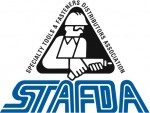STAFDA 2012: Human Resources Update
Nancye Combs, President, HR Enterprise
 |
 |
|
STAFDA Human Resourses consultant Nancye Combs will present her Human Resources Update from 9:00 to 11:00 a.m. on Sunday, November 4 in the West Building of the Orange County Convention Center. Check at the show for the room assignment. |
The State of Social Media Policy
The issues related to social media have become a growing concern for companies nationwide. Most agree that postings on Facebook, MySpace, Twitter, LinkedIn, YouTube and other blogs and message boards by irresponsible and disgruntled employees are alarming. The Society for Human Resources Management (SHRM) found that 40 percent of employers have already issued
a written policy. Many more are creating one at this time. The policies include a code of conduct for employees using social media (68 percent), a code of conduct for personal use by employees (66 percent) and guidelines for social media communication (55 percent).
The major concerns for employers are that employees are using social networking sites, blogs, instant communication sites and other methods of the proliferating Internet communication highway to trash the company. They are aware a threat exists that could damage the company image, harm its relationship with customers, criticize its products and services, cause it to lose its competitive edge or that posted information could cause expensive legal problems or put the safety of other employees at risk. They are alarmed that the electronic super highway does not police postings or have a concern for whether the postings are opinion or fact, or what impact they have on innocent and unsuspecting victims.
National Labor Relations Board Action
Actions by employers against employees, for what they describe as inappropriate conduct at a social network have drawn the attention of the National Labor Relations Board (NLRB), a powerful federal enforcing agency of the U. S. Department of Labor. Employees have claimed wrongful termination or retaliation for exercising their right to “grieve.”
The NLRB Associate General Counsel issued a 24-page opinion on May 30, 2012 regarding social media (this is #3). Those intimately knowledgeable of the issues said the NLRB took a “sledgehammer” to the policies of some of the nation’s leading companies, calling them unlawful because they produce a “chilling” effect on employee rights under the National Labor Relations Act.
Prominent labor attorneys commented on the NLRB opinion, describing it as “an utter mess,” a “bungled mess” and “inconsistent, overreaching; it’s a tepid mess.” Legal discussion included comments that indicate that the NLRB is attempting to make certain that social media policies “have no teeth to them.” It is utter nonsense to think that plastering the company logo on a picket sign and then posting it on the Internet is a harmless act.
Yet, companies are standing firm and fired back that they intend to hold their ground and protect their image, their brand, their stockholders, customers and employees. Whatever it takes, they intend to set the boundaries of what is acceptable employee behavior on social media sites and hold employees accountable.
Understanding the History
Reading the NLRB opinion is like watching grass grow to those lacking understanding of the importance of this decision, but it is alarming to those of us who do. It is helpful to know a little history and the players, to understand why this is such an irritant that the Board is raising its powerful voice with such a roar.
The National Labor Relations Act (the Wagner Act) was passed in 1935 because of the out-of-control conflict between labor and management in the U.S. Stories about the violence involving coal miners and railroad workers are infamous. The National Labor Relations Act (NLRA) is the law that contains the framework under which labor and management operate in the workplace.
The U. S. Department of Labor is the enforcing agency. The National Labor Relations Board is the politically appointed oversight and enforcing arm. The NLRB is the venue where employees go to seek recognition as the bargaining unit (union) for a company. It is the adjudicating body for Unfair Labor Practices filed by employees, unions and companies. Administrative law judges hear the unfair labor practice complaints and deliver a verdict. Although the ALJs are attorneys, don’t bet your ranch they are
pro-management.
The NLRB exists and operates to assure that employees have the freedoms afforded them by the National Labor Relations Act. These freedoms include the right to gather together and bargain “collectively” with an employer for such things as wages, benefits and working conditions, and it includes the freedom to “grieve and have their grievance heard.” The protection under the NLRA covers all non-management employees, both union and non-union. Management employees are not eligible for union membership and thus, not protected by the Act.
The leap your mind needs to take is to recognize that the NLRB has decided that an employee who posts complaints about an employer is exercising his/her rights under the NLRA. Thus, that is protected activity. Anything the employer does that “would reasonably
tend to chill employees in the exercise of their Section 7 rights,” would be targeted as an unlawful work rule by the NLRB (according to the opinion) and that includes policy statements.
Just how far the NLRB intends to stretch this definition is yet to be determined but the opinion suggested that it is harmless if an employee plasters the company logo on a picket sign and then blows it up for Internet publication! The lawsuits have not yet hit the courts, but they are on the way. Don’t expect employers to back down and give employees carte blanche to the Internet when it comes to protecting the business reputation. The latest NLRB report has stockholders also leaning forward to analyze the impact.
Where Do We Go From Here
Those of us who are management consultants in human resources issues and write social media policy have dissected the NLRB opinion issued on May 30. The legal community will lay down their challenges and the courts will decide just how much the NLRB can limit employers control over the social media postings of employees.
In its opinion, the NLRB offered a suggested policy which looks like a plain vanilla ice cream cone. Given the contents of their opinion and suggested policy, we are revisiting our policies and creating a new one that can withstand the challenge. CS
For up-to-the-minute STAFDA Convention news and exhibitor listings, visit www.stafda.org.
For more information, contact Nancye M. Combs, AEP, SPHR, at HR Enterprise, Inc., phone 502-896-0503; e-mail: nancyecombs@aol.com; or visit the website at www.HREnterprise.com.
















